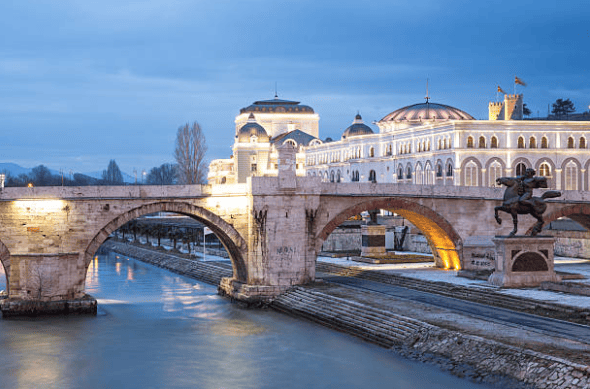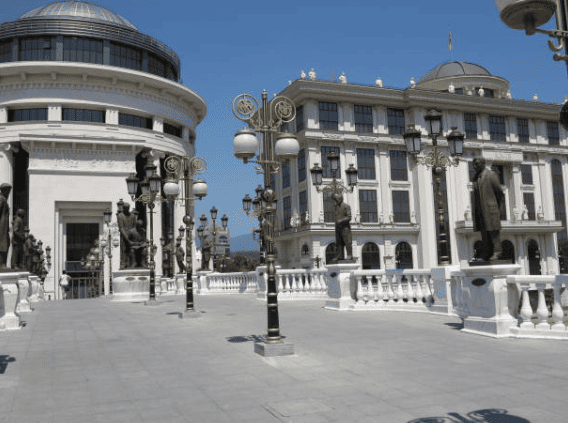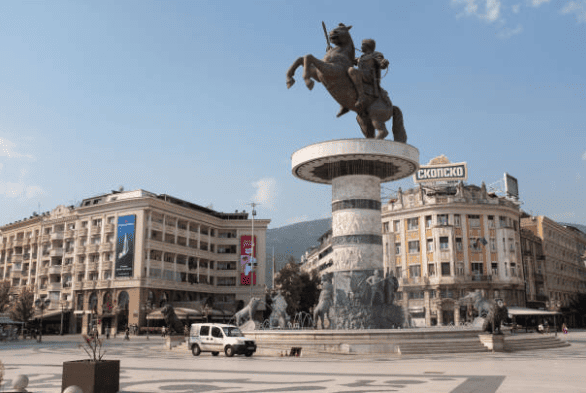I never imagined traveling to North Macedonia, let alone visiting its capital, Skopje. I had no clear idea about this country, formerly known as Macedonia. However, I was aware of Macedonia’s past conflicts with its neighbor Greece—rivalries akin to those between Indonesia and Malaysia.
North Macedonia only became a destination for me after my time in Kosovo. I searched for the closest and most affordable route to fly back to Istanbul, and out of options like Montenegro and Albania, flying from Macedonia turned out to be the cheapest. It was truly a last-minute decision.
After spending two days in Pristina, the capital of Kosovo, I headed to North Macedonia. The journey from Pristina to Skopje took around 2.5 hours by minivan. I entered North Macedonia with a multi-entry Schengen visa, and at the border, they did a standard check of my passport, onward ticket, and belongings.
I was the only tourist on board and therefore went through a slightly longer inspection—about ten minutes—while the other passengers waited. Thankfully, they were understanding, and once I got back to my seat, everyone seemed relieved, including me. I was excited, especially enjoying the scenery as we got closer to Skopje.
Kosovo and North Macedonia are both mountainous. The landscape from the border all the way to Skopje was full of green mountains and valleys, though not extremely high or deep. The road often ran parallel to a river, which added to the scenic journey.
Before I knew it, we were in the city. I didn’t even realize we were in Skopje until I checked Google Maps. Passengers gradually started getting off at various spots, and I eventually reached the final stop, Skopje’s main terminal.

The terminal is located in the city center, and I chose a hostel just 300 meters away. My reason for staying near the terminal was to make my trip to the airport easier later. From the hostel, the city center and main tourist spots were only about a kilometer away.
After checking in, I immediately set out to explore downtown Skopje. I didn’t want to waste any time, as I only had around 24 hours in the city. Walking from my hostel, I strolled along the pedestrian path, stopping by a large shopping center to find something to eat.
I arrived in Skopje around 2 p.m., and by then, I was starving. I entered a spacious restaurant with a self-service buffet. The dining area was separated by a barrier, so I had to pass through a turnstile to get my food. Inside, I chose Macedonian-style rice, vegetables, and a generous portion of chicken, paid at the cashier, and headed to my table. The price was affordable, paid in Macedonian Denar, where 1 Denar equals about 280 IDR.
From my seat, I could look out onto a calm street with minimal traffic. There was a peaceful atmosphere—no rush, no speeding vehicles, even on the wide road. I took my time enjoying my meal, taking in the tranquil view outside.
Tourist Attractions in Skopje, North Macedonia

After finishing my meal, I continued walking toward the city center. My first destinations were Plostad Makedonija, or Skopje Central Square, and the Mother Teresa Memorial House. These were the sites I was most eager to see in Skopje, North Macedonia. I walked along the pedestrian path by the Vardar River, which led to the heart of the city, occasionally passing locals jogging along the riverbank.
Skopje looked more charming than Kosovo, especially with its neoclassical city center. Hundreds of statues adorned the area, and on the opposite bank of the river stood beautiful buildings. There was even an old wooden ship on the river, now used as a restaurant.
I walked past it, heading first to Macedonia Square. This square was fascinating, dominated by a 22-meter-high monument in the center with a giant statue of a horseback rider on top. The statue actually represents Alexander the Great, the Greek hero who hailed from the Macedonian region.
Unfortunately, the statue sparked protests from Greece, which felt North Macedonia was claiming their national hero—similar to how Indonesia often protests Malaysia’s cultural claims. In the end, the statue was named Warrior on a Horse.

Besides Alexander the Great, the square is filled with other interesting statues and architectural structures. From here, I crossed the Vardar River via the historic Stone Bridge, which was built on Roman foundations between 1451 and 1469.
Then I turned toward the Macedonian Archaeological Museum building, which I’d seen from across the river. In front of the museum is the Eye Bridge, adorned with statues of heroes and notable figures. I took a few photos here, then moved on to the Art Bridge, which is decorated with 29 statues of Macedonian artists and musicians along both sides.

As night approached, I hurried to the Mother Teresa Memorial House. Although it’s not her original home, it was built to honor one of North Macedonia’s most famous figures and her lifelong dedication to humanitarian work and helping the world’s poor.
Outside the memorial, many Chinese tourists were taking turns photographing the statue of Mother Teresa. Worrying about closing time, I quickly went up to the second floor. Admission is free, although visitors are encouraged to leave a donation.
Inside, the house contains many of Mother Teresa’s belongings, including her bed, desk, and personal letters. Most of the displays consist of photos of her from youth to old age. It only took about half an hour to see everything inside.
When I stepped out of the memorial, it was already getting dark. I headed back to Macedonia Square and then walked back to my hostel. There, I prepared a meal, had dinner, and relaxed with other guests in the common room.
Exploring the Old Town and Old Bazaar

North Macedonia has many Ottoman-era relics that can still be seen today, with one of the most intriguing being the Old Bazaar in Skopje’s historic old town. A visit to Skopje feels incomplete without exploring the Old Bazaar. It’s not far from the modern Macedonia Square, and the Stone Bridge, or Kameni Most, connects this modern part of the city with the historic Ottoman quarter.
Crossing the bridge leads directly to the Old Bazaar, or Caršija. But before heading there, I stopped at the left end of the Stone Bridge, where you’ll find the Museum of the Macedonian Struggle, which commemorates the history of colonization, and the Holocaust Memorial Center for the Jewish community in North Macedonia.
Continuing on to the Old Bazaar, I was reminded of the Grand Bazaar in Istanbul. The Old Bazaar is a labyrinth of small streets filled with cafes, jewelry shops, bakeries, and general stores. It resembles the Grand Bazaar but is smaller and open-air.
This bazaar, dating back to the 12th century, features several Turkish-style mosques, such as the Mustafa Pasha Mosque from the Ottoman period. Other fascinating Ottoman landmarks include the Suli An Art Center, which was once a caravanserai, and the Daud Pasha Hamam, a bathhouse with 13 domes. This 15th-century hamam now serves as part of the National Gallery.
Still within the Old Bazaar area is the Museum of the Republic of North Macedonia, one of the oldest museums in the country. It was formed by combining three museums: the Archaeological Museum (considered the oldest), and museums of history and ethnology. Opened in 1924, this date is celebrated as the founding of the national museum.
I stayed at the museum until midday, wrapping up my visit as I needed to head back to the hostel. On my way back, I passed the Mustafa Pasha Mosque, which sits on a hill, and the Skopje Fortress. The remains of this 6th-century stone fortress at the top of the hill offer beautiful views of the city and the river, but I didn’t have time to stop.
After completing my sightseeing for the day, I flew to Istanbul in the evening, concluding my trip to the Balkans and preparing to return to Indonesia.
